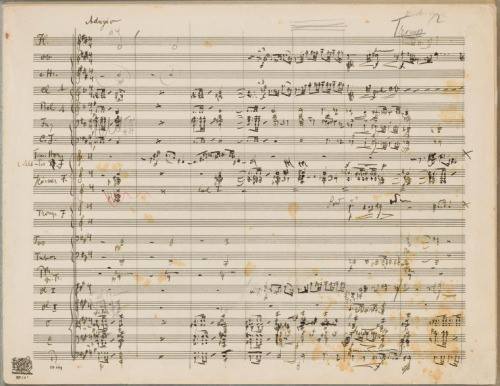- First movement.
- Moves from B minor (introduction) to E minor.
The movement is in sonata form. It begins with a slow introduction in B minor, launched by a dark melody played by a baritone horn. The accompanimental rhythm was said to have come to Mahler whilst rowing on the lake at Maiernigg after a period of compositional drought. The principal theme, presented by horns in unison in E minor, is accompanied similarly, though much faster and in a higher register.
The second theme is then presented by violins, accompanied by sweeping cello arpeggios. This theme is infected with chromatic sequences. At one point the violins reach an F#7, the highest F# on the piano. The exposition is wrapped up with a march theme from the introduction, which is followed by a repeat of the principal theme.
Movement 1: Langsam (Adagio) – Allegro risoluto, ma non troppo.
Movement 1: Langsam (Adagio) – Allegro risoluto, ma non troppo. Manuscript of the tenor horn solo, bars 2-4.
This leads straight into the development, which continues for some time before suddenly being interrupted by pianissimo trumpet fanfares and a slow chorale based on the march theme from the introduction. This section has been interpreted as a ‘religious vision.’ It has also been asserted that this section contains the chains of fourths that impressed Arnold Schoenberg (1874-1951).
After this section plays itself out, a harp glissando propels the music into a new section based on the second theme and the march/chorale theme. But before a climax can be articulated, the final cadence is interrupted by the music from the introduction and the Baritone horn arioso.
Part of a draft orchestral score of Movement 1: Langsam (Adagio) – Allegro risoluto, ma non troppo. “Maiernigg 15-08-1905. Septima finita.”
This leads into the recapitulation, but before the actual recapitulation occurs, there is an incredibly difficult high note for trumpet. In fact, the principal trumpet for the work’s premiere even confronted Mahler, saying “I’d just like to know what’s beautiful about blowing away at a trumpet stopped up to high C-sharp” Mahler had no answer, but later pointed out to Alma that the man did not understand the agony of his own existence.
The recapitulation is very similar to the exposition, although it is significantly more agitated. There is a grand pause during the first thematic section that leads into a massive climax. The second theme is also considerably shortened. The march theme from the introduction leads straight into an epic coda that features march rhythms and multiple high points in the orchestral texture, before ending on an E major chord.
Part of a draft orchestral score of Movement 1: Langsam (Adagio) – Allegro risoluto, ma non troppo.
Part of a draft orchestral score of Movement 1: Langsam (Adagio) – Allegro risoluto, ma non troppo. Next to the figures played by the low strings in the later bars 284ff, Gustav Mahler wrote ‘Steine pumpeln / ins Wasser (stones bouncing / into the water).
Part of a draft orchestral score of Movement 1: Langsam (Adagio) – Allegro risoluto, ma non troppo.
Part of a draft orchestral score of Movement 1: Langsam (Adagio) – Allegro risoluto, ma non troppo.
Page from a copyist’s manuscript of Symphony No. 7 made after the Royal Concertgebouw autograph, including many changes made by Gustav Mahler. Austrian National Library, Vienna.
Pages from a copyist’s manuscript of Symphony No. 7 made after the Royal Concertgebouw autograph, including many changes made by Gustav Mahler.
Movement 1: Langsam (Adagio) – Allegro risoluto, ma non troppo.
Listening Guide

